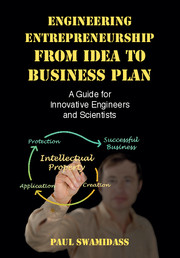References and Selected Bibliography
Blanchard, K. (2007). Leading at a Higher Level. Upper Saddle River, NJ: Pearson.
Blank, Steve and Bob Dorf. (2012). The Startup Owner’s Manual: The Step-by-Step Guide for Building a Great Company, Pescadero, CA: K and S Ranch Publishers, Inc.
Brandt, L. and Rawski, T. G. (2008). China’s Great Transformation, Cambridge, UK: Cambridge University Press.
Christensen, C. M. (1997). The Innovator’s Dilemma, Boston, MA: Harvard Business School Press.
Christensen, C. M., & Raynor, M. E. (2003). The Innovator’s Solution, Boston, MA: HBS Press.
Davis, M. (2003). What can we learn by looking for the first code of professional ethics? Theoretical Medicine and Bioethics, 24(5): 433–454.
Dyson, J. (2003). Sir James Dyson, Against the Odds: An autobiography (2nd ed.), New York: Texere, LLC.
Gage, D. (2012). The venture capital secret: 3 out of 4 start-ups fail. The Wall Street Journal, Sept. 19.
Goleman, D., Boyatzis, R. E., & McKee, A. (2002). Primal Leadership: Realizing the Power of Emotional Intelligence. Boston, MA: Harvard Business School Press.
Grove, A. (1996). Only the Paranoid Survive: How to Exploit the Crisis Point that Challenge Every Company. New York: Doubleday.
Hickman, G. R. (Ed.). (2010). Leading Organizations: Perspectives for a New Era (2nd ed.). Thousand Oaks, CA: Sage.
Hölzl, W. (2010). The economics of entrepreneurship policy: Introduction to the special issue. Journal of Industry, Competition and Trade, 10, 187–197.
Isaacson, W. (2011). Steve Jobs. New York: Simon and Schuster.
Keeney, R. L. (1996).Value-Focused Thinking: A Path to Creative Decision Making. Boston, MA: Harvard University Press.
Kouzes, J., & Posner, B. (2007). The Leadership Challenge (4th ed.). San Francisco, CA: Josey-Bass.
Kwoh, L. (2012). You call that innovation? The Wall Street Journal, www.WSJ.com May 23.
Morgan, G. (2006). Images of Organizations. Thousand Oaks, CA: Sage.
Morrisette, S., & Schraeder, M. (2007). Affirming entrepreneurship: The best hope for organizations. Development and Learning in Organizations, 21(1), 15–17.
Osterwalder, A., & Pigneur, Y. (2010). Business Model Generation. Hoboken, NJ: John Wiley.
Peel, S., & Inkson, K. (2004). Contracting and careers: Choosing between self and organizational employment. Career Development International, 9(6/7), 542–558.
Ries, E. (2011). The lean Startup: How Today’s Entrepreneurs Use Continuous Innovation to Create Radically Successful Businesses, New York: Crown Business.
Roberts, R., & Wood, W. (2007). Intellectual Virtues: An Essay in Regulative Epistemology. Oxford, UK: Oxford University Press.
Rus, D., van Knippenberg, D., & Wisse, B. (2012). Leader power and self-serving behavior: The moderating role of accountability. The Leadership Quarterly, 23(1), 13–26. doi: 10.1016/j.leaqua.2011.11.002.
Schyns, B., & Hansbrough, T. (Eds.). (2010). When Leadership Goes Wrong: Destructive Leadership, Mistakes, and Ethical Failures. Charlotte, NC: Information Age Publishing.
Swamidass, P. (2010b). Reforming the USPTO to comply with MPEP section 707.07(J) to give a fair shake to pro se inventor-applicants. John Marshall Review of Intellectual Property Law, 9(4), 880–911.
Swamidass, P. (2014). Engineers and scientists: Value creators in the seven-phased model of technological innovation. Technology and Innovation, 16 (3-4), 223−232.
Swamidass, P., & Schnittka, C. (Forthcoming). Funding and preparing teachers to meet the needs of US student innovators in the making, in Technology and Innovation, the Journal of The National Academy of Inventors.
Ulrich, K., & Eppinger, S. (2015). Product Design and Development (6th ed.). New York: McGraw-Hill Education.
Utterback, J. M. (1996). Mastering the Dynamics of Innovation. Boston, MA: HBS Press.
van Knippenberg, B., & van Knippenberg, D. (2005). Leader self-sacrifice and leadership effectiveness: The moderating role of leader prototypicality. Journal of Applied Psychology, 90, 25–37.





